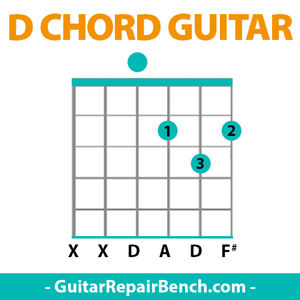 Learning to play the D chord on guitar is easy. It has several different chord variations and finger positions on the fretboard.
Learning to play the D chord on guitar is easy. It has several different chord variations and finger positions on the fretboard.
The D major chord is definitely one of the more popular chords on the acoustic guitar because it can be used in many different ways. It’s a great guitar chord for beginners to experiment with addons, pull offs, and suspended chord shapes and sound textures.
Let’s learn how to play a D chord along with the music theory of the key of D.
What is a D Major Chord on Guitar?
Contents
What notes are in a D chord?
D major is a triad chord compound by three notes: D, F#, and A. D is the root note and F# is the major third two steps from the root. A is a perfect fifth or three and a half steps from the root D note.
When working on D major key, it’s important to remember that there are two sharps that are involved: F sharp and C sharp. Going back to the circle of fifths, we picked up our F# from the key of G and then added a C# since it’s the 7th interval in the key of D.
Thus, the D major scale is as follows: D – E – F# – G – A – B – C# – D.
D Chord Guitar Finger Positions
You can easily play the D chord on acoustic guitar in six different positions up to the 12th fret on the guitar neck. Here are the most common D chord positions on the fretboard.
- Open chord
- 2nd position
- 5th position
- 7th position
- 10th position
- 12th position
How to Play an Open D Chord on Guitar
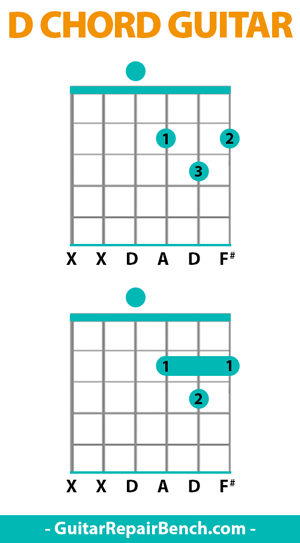 D major can be played in the open chord position using two different D chord variations and finger positions.
D major can be played in the open chord position using two different D chord variations and finger positions.
Open D Major Finger Position #1
Start by placing your 1st finger on the 2nd fret of the G string.
Then, put your 2nd finger on 2nd fret of the E string. After that, set your 3rd finger on the 3rd fret of the B string.
Now strum the first 4 strings. You don’t have to include the 5th and 6th strings, so that way you can keep the D note in the base of the chord.
Open D Major Finger Position #2
Another way to make an open D on the guitar is to simply barre the first 3 strings on the 2nd fret. Then use your 2nd finger to play the 3rd fret of the B string.
This is a great way to not only make the open chord, but it’s also a good way to practice barre chords in general. You can use this to build up the strength in your first finger.
Short tip for beginners: When learning how to play D major open chord, often the main challenge is being able to get a clean pitch out of the e string, which tends to sound sort of “drowned.”
If you find yourself at this point, before applying more pressure to the left hand (right hand if you’re left handed), bear in mind that this problem is usually due to the fact that the 3rd finger (the one that is pressing the B string) is touching the e string with its inner side, not allowing the note on the e string to be projected clearly.
To solve this, make sure to set your fingers as vertically as possible, so that each finger touches just and only the string that is meant to touch.
5 Different D Chord Guitar Variations
How to Play a D Chord at the 2nd Fret
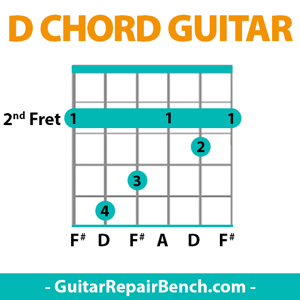 The 2nd position D major chord can be played using a full barre across all the frets.
The 2nd position D major chord can be played using a full barre across all the frets.
Use your 1st finger to make a bar across on 2nd fret, pressing the first four strings of the instrument.
Then, bring your 2nd finger to the 3rd fret of the B string.
Finally, put your 3rd finger on the 4th fret of the D string.
Using this shape, you can strum the first 5 strings. If you want to add another F# in the bass of the chord, you can extend your first finger barre across the 6th string as well.
How to Play a D M Guitar Chord at the 5th Fret
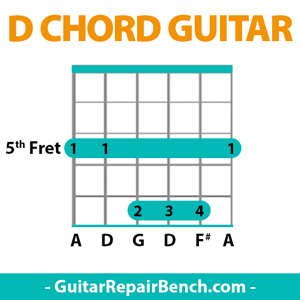 Begin by putting your 2nd finger on the 7th fret of the D string.
Begin by putting your 2nd finger on the 7th fret of the D string.
Next, place your 3rd finger on 7th fret of the G string, and right after that, set your 4th finger on the 7th fret of the B string.
Lastly, make a whole bar with your 3rd finger throughout the 5th fret – in this case, the E string can be left aside since the right hand won’t be playing it.
D Major Chord Guitar tip: This shape can be played a few different ways. You can barre the entire neck or just the first 5 strings. You can also try to do a double barre with your first finger across the 5th fret and your third finger across the 7th.
How to Play a D M Chord at the 7th Fret
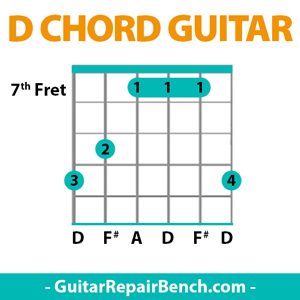 Use your 1st finger to make a half bar on 7th fret, pressing the first four strings of the guitar.
Use your 1st finger to make a half bar on 7th fret, pressing the first four strings of the guitar.
After that, position your 3rd finger on the 10th fret of the low E string and your 2nd finger on the 9th fret of the A string.
Finally, stretch your 4th finger back to the 10th fret of the high e string and strum everything!
Guitar Chord Shape Tip: This chord shape looks a lot like an open G chord. Doesn’t it? Well, that’s because it’s the same shape. Think of your first finger barre like the nut of guitar. You might find it easier to make the G chord shape first and then try to put down your first finger. That’s what I do.
How to Play a D Major Guitar Chord at the 10th Fret
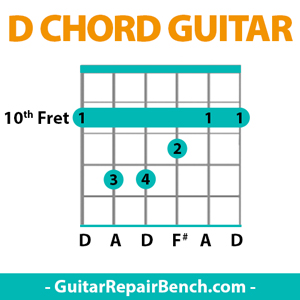 Position your 3rd and 4th fingers on the 12th frets of the A and D strings respectively.
Position your 3rd and 4th fingers on the 12th frets of the A and D strings respectively.
Next, place your 2nd finger on the 11th fret of the G string.
Now, use your 1st finger to press down on the 10th fret of all the strings.
D Guitar Chord Position Tip: This is your classic barre chord shape that the rock’n’roll power chord is derived from. It’s also the same shape as the open E chord. Sometimes I find it easier to make the shape with my 2-4 fingers before laying down the barre with my first. Try it out and see which one works better for you.
How to Play a D Major Chord on the 12th Fret
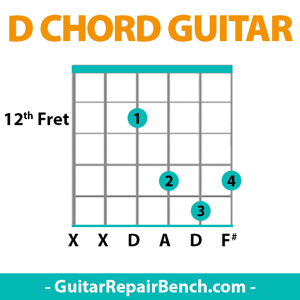 The D-chord at the 12th fret is one octave higher than the open D that we learned at the start of this lesson. This means the D M chord shape will at the 12th fret will look identical to the one in the open position. See what I mean in the D guitar chord chart?
The D-chord at the 12th fret is one octave higher than the open D that we learned at the start of this lesson. This means the D M chord shape will at the 12th fret will look identical to the one in the open position. See what I mean in the D guitar chord chart?
First, put your 1st finger on the 12th fret of the D string. This is your octave.
Now put your 2nd finger on the 14th fret of the G string and your 4th finger on the 14th fret of the high E string.
Lastly, use your 3rd finger to press down the 15th fret of the B string and strum the first 5 strings. Now you can play D chords on the guitar neck up one octave.
Now It’s Time to Start Playing
Congratulations, you know how to play D on guitar! D is one of the most fundamental guitar chords because it can be used in so many different keys. That’s why it’s a prefect beginner guitar chord to start with.
It can be a little tricky playing the open chord without hitting your 3rd finger on the 1st string, but you will get used to it and you’ll soon figure out how to hammer-on and pull-off your with your 2nd and 4th fingers to create new suspended chords.
It’s super fun! If you want to learn more about how to play D chords and what you can do with them in a song, you should take some guitar lessons. The easiest and fastest way to learn how to play guitar is by taking online lessons. You can learn any song, technique, or theory. It’s all there. I highly recommend it to anyone who wants to be a better guitarist.

